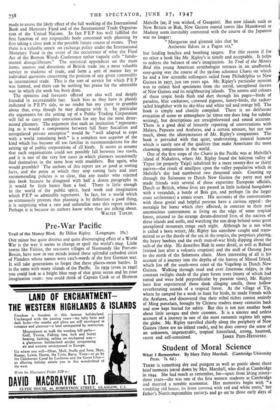Student of Moral Science
What I Remember. By Mary Paley Marshall. (Cambridge University Press. 7s. 6d.) THERE is something dry and pungent as well as poetic about these briermemoirs jotted down by Mrs. Marshall, who died at Cambridge in 1944. She had much to remember, for—apart from living ninety- three years—she was one of the first women students at Cambridge and married a notable economist Her memories begin with "a rambling old house, its front covereci with red and white roses," her father's Northsmptonshire rectoty, and go onto those early days of
Newnham College (five students and Miss Clough at Regent Street, Cambridge), and then to her marriage in 1877 to Alfred Marshall, who had helped to coach her for the Moral Science Tripos, and their life in Bristol, Oxford and Cambridge. After Professor Marshall's death, Mrs. Marshall continued for twenty years to live at the houAe in the Madingley Road that they had built, and, having presented her husband's library to the University, herself acted as honorary assistant librarian, cycling to the Marshall Library every day until she was nearly ninety, "wearing," said Keynes, "as she always did, the sandals which were a legacy of her pre-Raphaelite period sixty years before." Towards the end of her life she showed Dr. Trevelyan (who writes the introduction) her memoirs, and he per- suaded her to allow them to be published after her death.
They are very ihort--only fifty pages—but with their engaging quality of casual under-statement they give far livelier pictures of university life than many more ponderous volumes. The few last sentences are touching and typical: "His [her husband's] memory gradually became worse, and soon after his doctor told me quietly that 'he sejIl not be able to construct any more.' And it was so, though fortunately he did not know it. For in the old days he used to come down from his study and say : I have had such a happy time, there is no joy to be compared to constructive work."
Those who know Oxford will be interested in the Jowett stories- " the little man with a pink face and white hair" whom a malicious friend called "light without warmth." There are some sensitive patches of description of Palermo—the Cappella Palatina, "a mass of dim golden shadows "—where the Marshalls lived for a recumrative five months. But perhaps the most general interest lies in those early days at Cambridge, the women students, with their smooth, young faces and pompous clothes (as shown in several photographs), kept in such order by the famous Miss Clough that it was considered a sin to spend a day at Ely chiefly in the Cathedral." There is something very attractive about these young women who were setting their faces against the conventions, building up friendships, having their private jokes and yet working hard. Mary Paley, indeed, worked hard enough to be placed "between heaven and hell" in the Moral Science Tripos, for two of the examiners voted her first-class and two second-class, and they could not agree ; and the fact was recorded on her certificate.
The careers of many of these early students petered out ; they were perhaps not as remarkable as they appeared in the 'seventies. Mrs. Marshall's "life was wholly merged" into her husband's. But these memoirs with their humour—" equable humorous loving- kindness," Keynes said—and sense of style make one feel that that eager effort of learning was worth while if it did nothing more than help to produce the kind of character mirrored here.
GWENDOLEN FREEMAN.



































 Previous page
Previous page